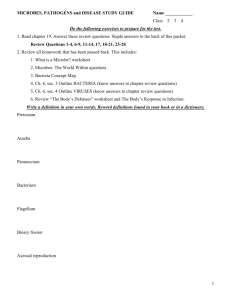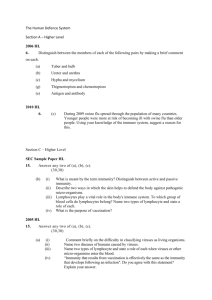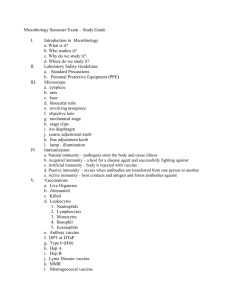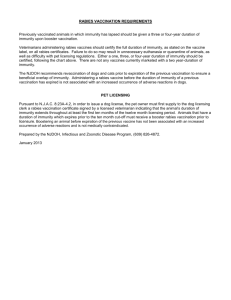CLF278
advertisement
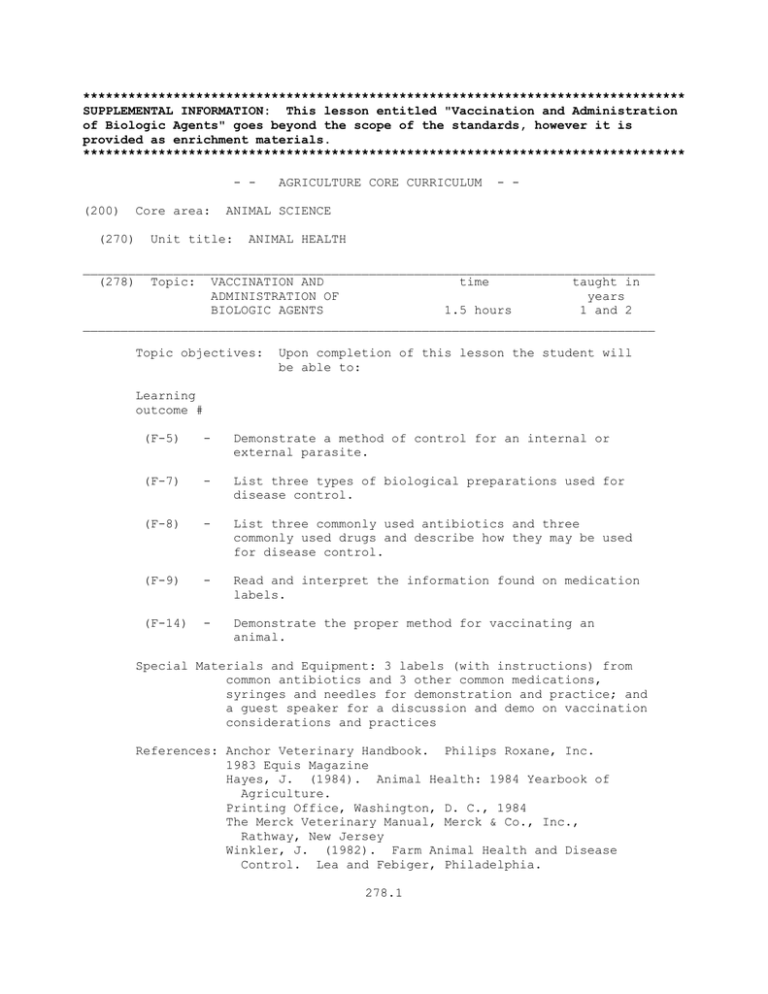
******************************************************************************** SUPPLEMENTAL INFORMATION: This lesson entitled "Vaccination and Administration of Biologic Agents" goes beyond the scope of the standards, however it is provided as enrichment materials. ******************************************************************************** - (200) (270) Core area: AGRICULTURE CORE CURRICULUM - - ANIMAL SCIENCE Unit title: ANIMAL HEALTH ____________________________________________________________________________ (278) Topic: VACCINATION AND time taught in ADMINISTRATION OF years BIOLOGIC AGENTS 1.5 hours 1 and 2 ____________________________________________________________________________ Topic objectives: Upon completion of this lesson the student will be able to: Learning outcome # (F-5) - Demonstrate a method of control for an internal or external parasite. (F-7) - List three types of biological preparations used for disease control. (F-8) - List three commonly used antibiotics and three commonly used drugs and describe how they may be used for disease control. (F-9) - Read and interpret the information found on medication labels. (F-14) - Demonstrate the proper method for vaccinating an animal. Special Materials and Equipment: 3 labels (with instructions) from common antibiotics and 3 other common medications, syringes and needles for demonstration and practice; and a guest speaker for a discussion and demo on vaccination considerations and practices References: Anchor Veterinary Handbook. Philips Roxane, Inc. 1983 Equis Magazine Hayes, J. (1984). Animal Health: 1984 Yearbook of Agriculture. Printing Office, Washington, D. C., 1984 The Merck Veterinary Manual, Merck & Co., Inc., Rathway, New Jersey Winkler, J. (1982). Farm Animal Health and Disease Control. Lea and Febiger, Philadelphia. 278.1 Evaluation: TOPIC PRESENTATION: PART I: Vaccination Quiz/test by instructor and evaluation of vaccination and other skills by the teacher as the students demonstrate the technique on a live or simulated animal. VACCINATION AND ADMINISTRATION OF BIOLOGIC AGENTS A. A vaccination is the injection of some agent (such as bacterin, serum or vaccine) into the animal for the purpose of developing disease resistance (immunity). B. It is important to keep in mind that by itself, a vaccine does not confer immunity, it only stimulates an animal's own immune system into action. C. Biologicals, biologics or biological products are all terms that cover materials used for vaccination. D. Biologic agents used in developing resistance: 1. 2. Living viruses are used to stimulate antibody production against a specific virus without the animal contracting the disease. a. Living (unmodified) viruses are actual living viruses that are administered to (usually) young animals when their expected reaction will be mild. b. If it is a dangerous virus, it is administered with an "antiserum" (to help the animal's body fight the virus until the animal's system makes its own antibodies) to help stimulate the immune response. c. Living viruses confer (grant or provide) an effective and lasting immunity. Killed or inactivated viruses are administered to a susceptible animal to stimulate active immunity (body generates its own immunity) in the animal. a. 3. Although the response is usually very strong, it is suggested that the process be repeated every 12 months.. Modified live viruses (MLV) are a product which contains a live virus but has been changed or modified so as to not cause the disease but still stimulate antibody formation against the disease. a. The modified virus is collected from an unnatural host (other than the type of animal that normally is the host for the pathogen. 1) An example is hog cholera - it is allowed to grow in an embryonated egg (the unnatural host), collected, processed and used to vaccinated the host. 2) Another example is canine distemper vaccine. 278.2 b. 4. A bacterin is made of the killed preparation of the disease-causing bacteria; it will not cause disease or spread, but stimulates antibody formation. a. 5. These agents have a relatively lower power to confer immunity and must be re-administered at least once every 12 months. Toxoids are an inactivated, altered toxins (the poison that is produced by pathogenic bacteria) used to stimulate immunity. a. 6. This type of vaccine confers an effective and long lasting immunity. Toxoids provide long-lasting protection against problems such as tetanus and enterotoxemia. Antisera including antitoxins are blood serums containing antibodies which are injected into unprotected animals, stimulating antibody formation. a. This creates "passive" (it is received by using antibodies from the injection - instead of generating any) immunity which is immediate, but short-lived. 1) PART II: A. An example is tetanus antitoxin. Administering Biologic Agents Read carefully and understand all the information on the medication label. 1. Never use medication on animals other than as prescribed in the directions. 2. Be aware of brand versus generic names for medicines (Know what you are buying.) 3. Be aware of side effects (unexpected and dangerous responses to injections or drugs). 4. Use the proper amount of medication in relation to the size of the animal 5. Be sure to follow the storage instructions. 6. Check the expiration date - if it is old, throw it away!!! it will be ineffective, at worst it could be poisonous!) 7. Be certain that you have read the information and are sure of the best method of administration of the compound. 278.3 (At best _________________________________________________________ ACTIVITY: Bring in three commonly used antibiotics and three other drugs. Have students read and outline medication labels, and then have them write a paragraph on the use of the antibiotic to control the disease. __________________________________________________________ B. Methods of application include: 1. by sprays and dusts 2. through inhalation; 3. by mouth (oral) 4. in drinking water; 5. by absorption - painting the anus, dipping the entire animal, or capsules in the ear; and 6. by injection. a. - used often with poultry; - pills, tablets, paste, food additives, etc.; The methods of injection include: 1) 2) intramuscular (IM) injections: a) most commonly used for antibiotics, vaccines and wormers; b) are easy to administer in large muscles of neck or thigh; and c) must be injected into the muscle tissue, not a blood vessel, hence the need to "aspirate" (pull back on the syringe plunger to be sure the needle isn't in a blood vessel) before injecting the compound. Subcutaneous (Sub-Q) injections are: a) the injection of the compound (fluid) directly beneath the skin, not in the flesh or a blood vessel; and b) are easy to do where the skin lies in loose folds such as under the mane in horses, on the back of the neck in dogs, and behind the ear in swine. 3) Intradermal injections (ID): a) are made between the skin layers, not beneath it; and b) are done with a very fine gauge needle. 278.4 4) Intravenous injections (IV): a) are injected directly into a blood vessel (using ones that are easily identified and accessible); and b) the action of drug is usually almost immediate (15 to 60 seconds) after injection. Therefore solutions should be injected slowly to avoid side effects or the "shock" of too much at once. _________________________________________________________ ACTIVITY: On the farm or in the lab, demonstrate the proper way to vaccinate an animal, then have students do it. If there is no need for injections of specific compounds for the group of animals being worked with, (those management practices having already been done) injections of sterile saline or water solution can be used. Be sure before doing this that you are not violating safe practices or animal welfare or school regulations. (It may be advisable to have an animal health care specialist available if you decide to "practice" on live animals, or perhaps practice on oranges and not use live subjects.) Another concern is the possibility of the students accidentally vaccinating themselves. It would be best not to use live or live attenuated vaccines for this exercise (like the brucellosis vaccine). A student could become very ill if injected with some vaccines. Invite your veterinarian in to demonstrate proper techniques and consult with that person on places to obtain sterile water, syringes, etc., and animal health regulations governing the use of animals for this lab exercise. __________________________________________________________ 278.5
